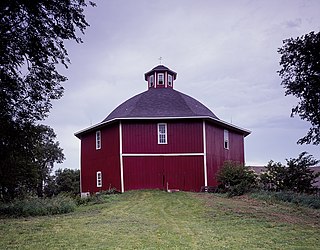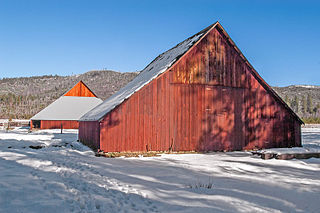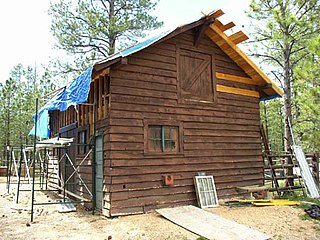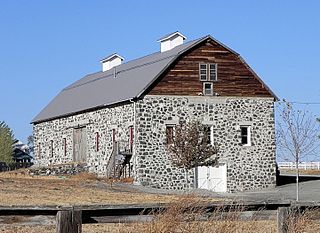
Ron George Round Barn is a round barn northeast of the U.S. village of Romeoville, Illinois. It was originally constructed for Frank Eaton c. 1912–13 in Bolingbrook, Illinois.

The University of Wisconsin Dairy Barn is a building located on the campus of the University of Wisconsin–Madison. Built in 1897, the building played an important role in the field of dairy science during the 20th century. It has been used both as a teaching facility and as a site for agricultural research. It is significant for its association with the single-grain experiment, performed from 1907 to 1911 by Stephen Babcock. The UW Dairy Barn was declared a National Historic Landmark in 2005.

The Secrest Octagon Barn is a historic building located near Downey in rural Johnson County, Iowa, United States. It was constructed in 1883 by master builder George Frank Longerbean for Joshua Hunt Secrest as a hay barn-horse stable. The octagonal barn measures 80 feet (24 m) in diameter. It features red vertical siding and a sectional bell shaped roof that is supported by hand-laminated beams. The octagon-shaped cupola has the same roof shape as the barn. It was listed on the National Register of Historic Places in 1974.

The Lame–Smith House and the Sydney and Gertrude Smith Barn, about one mile northwest of Halsey, Oregon, are historic structures that were listed on the National Register of Historic Places in 1999.

The Nebergall "Knoll Crest" Round Barn is located between Davenport and Blue Grass in rural Scott County, Iowa, United States. It was built in 1914, and has been listed on the National Register of Historic Places since 1986.
The George Darrow Round Barn is a historic building located near Alta Vista in rural Chickasaw County, Iowa, United States. The true round barn was constructed of clay tile in 1916. The use of clay tiles suggests that it was influenced by the work of the Iowa Agricultural Experiment Station in the early 20th-century. It has a diameter 64 feet (20 m), and a height of 50 feet (15 m). The barn features a two-pitch roof and a 14-foot (4.3 m) central clay tile silo. It was built as a dairy barn and it was used as such until 1978. Dairy cow stanchions surround the central silo on one side of the barn in a circular arrangement, and horse stalls surround the other side. The barn has been listed on the National Register of Historic Places (NRHP) since 1986. It has subsequently been torn down. It was removed from the NRHP in 2022.
The Wickfield Round Barn is a historic sale barn building located near Cantril in rural Van Buren County, Iowa, United States. Originally called Silvers Sale Pavilion, it was built in 1919 by Alva Hunt for $20,000. The true round barn measures 50 feet (15 m) in diameter. Frank Silvers, a successful hog breeder and businessman, operated the largest Hampshire hog farm in the world. The first floor had seating for 700 people. Silvers' business offices were also located on the first floor. The structure is constructed of clay tile and features an aerator. The two-pitch roof features eight dormers on the lower part and four dormers on the upper part of the roof. It has been listed on the National Register of Historic Places since 1986. There are no round barns in Iowa used as sale barns any longer, and this one is used for storage.

The McCauley and Meyer Barns in Yosemite National Park are the last barns in the park that retain their original characteristics as structures built by homesteaders. The McCauley barn and the two Meyer barns represent different construction techniques and styles of design.

The Horse Barn at Bryce Canyon National Park, Utah, is a rustic structure built in 1929, shortly after the National Park Service assumed control of the new park lands from the U.S. Forest Service. The Park Service set about improving facilities in the park, using a design by the Park Service Branch of Plans and Designs. It is listed on the National Register of Historic Places as an example of NPS design work of the late 1920s.

The El Tovar Stables at the south rim of the Grand Canyon were built about 1904, at the same time the nearby El Tovar Hotel was built, to house the animals used in general transportation around the park. Collectively called the "transportation department" in the early 20th century, the three structures comprised a horse barn or stable, a mule barn and a blacksmith shop.

The Horseshoe Lake Ranger Station in Lassen Volcanic National Park, California is a backcountry ranger station that was built by Civilian Conservation Corps labor in 1934. The cabin typifies National Park Service standard designs for such structures in the prevailing National Park Service Rustic style then used by the Park Service. It is the only such example of a standard-plan backcountry ranger station in Lassen Volcanic National Park. There were originally two structures at the site, the residence, and a now-vanished barn.
The Thompson-Wohlschlegel Round Barn near Harper, Kansas is a round barn that was built during 1910 to 1913. It was listed on the National Register of Historic Places in 1985, and was delisted in 2020.

The Louis Rehm Barn near Hebron, North Dakota, United States, was built in 1917. It was built by Adam Rehm and, in 1994 was owned by Armin Rehm. It is also known as the Armin Rehm Barn. The barn was listed on the National Register of Historic Places in 1994. Other farm buildings were of lesser significance or integrity so were not nominated.

The Jacob B. Van Wagener Barn is lava rock structure built in 1912. It located in Jerome, Idaho, United States, and was listed on the National Register of Historic Places in 1983.

The Saint Mary Ranger Station is a ranger station in Glacier National Park in the U.S. state of Montana. The log cabin was built in 1913 on the east side of the park overlooking Upper Saint Mary Lake. The oldest administrative structures in the park., it features an architecture that foreshadows the National Park Service Rustic style.
The Jacob D. Goosen Barn is a historic barn in rural Sully County, South Dakota about 1/2 mile east of Onida on the north side of East Onida Road. Built in 1904, it was built with a Shawver truss roof, a form popular in other areas, but not widely adopted in South Dakota. This truss method used lighter-weight framing, which transferred the roof's dead load to the walls, enabling the removal of interior posts. The barn is 50 feet (15 m) wide and 100 feet (30 m) long, with a high gambrel roof that characterizes the use of the Shawver truss.
The Acre Family Barn, in Blaine County, Oklahoma near Canton, Oklahoma, was listed on the National Register of Historic Places in 2013.
The George Becker House, near Los Ojos, New Mexico, was built in 1918–19. It was listed on the National Register of Historic Places in 1985.

The Gottfried Gustav Pitz Barn in Cass County, Nebraska near Plattsmouth, Nebraska is a German banked barn built in 1883 by Gottfried Gustav Pitz. It was listed on the National Register of Historic Places in 2012.














